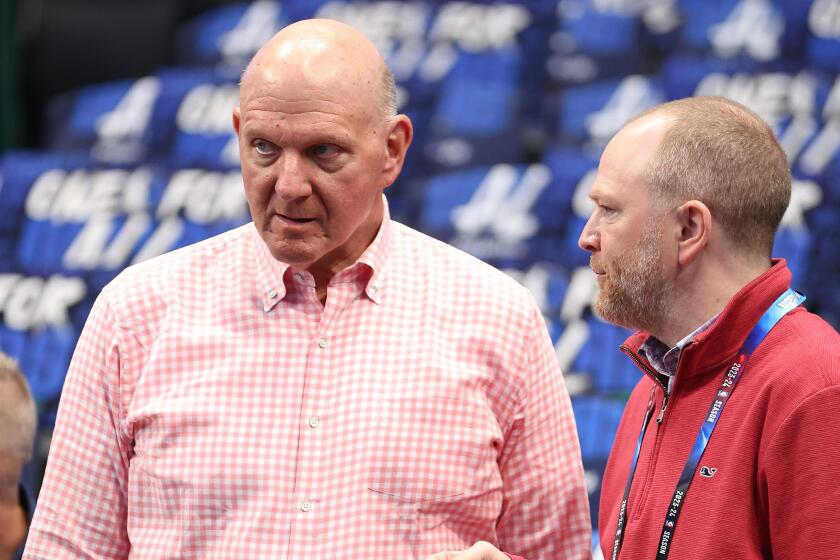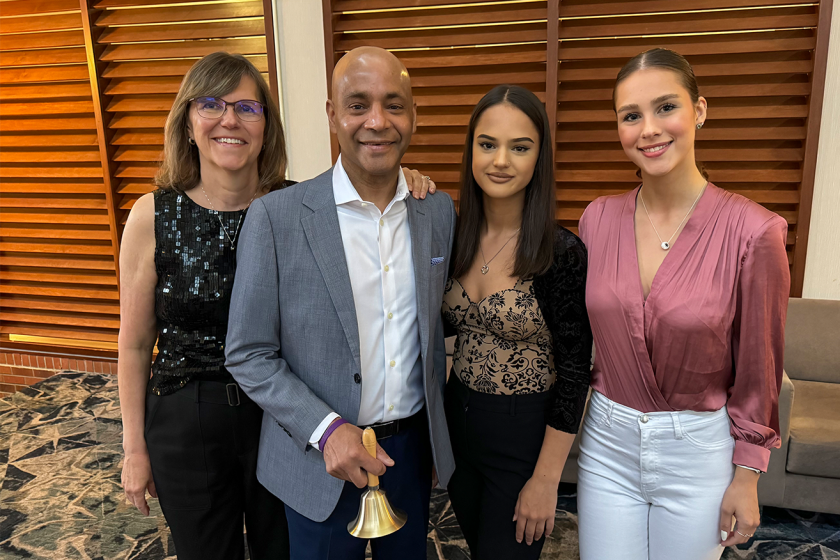BASEBALL / ROSS NEWHAN : Royals’ Rebound Definitely Worth Yelling About
The Kansas City Royals never recovered from their 1-16 start of last season, ultimately finishing fifth in the American League West with a 72-90 record.
It is a different season and a different team.
A 2-9 start revived memories of 1992, but only briefly.
“Some people were calling it another disaster, but the players never believed it,” General Manager Herk Robinson said. “They were confident all along they were capable of winning.”
Easy to say now, of course, with the Royals in sole possession of first place in the West for the first time since June 8, 1987. Easy to say after a 27-15 rebound.
Easy to say this and believe it as well: The Royals are a different team, primarily because they are better defensively.
The signings of free-agent shortstop Greg Gagne and free-agent second baseman Jose Lind, along with the acquisition of right fielder Felix Jose in trade for Gregg Jefferies, have helped stabilize the defense and improved the confidence of the pitchers.
“Our defense is as good as any in baseball,” Robinson said. “We’re airtight up the middle with Gagne, Lind and Brian McRae in center.
“The pitching staff feels the only way to get a ball through the gaps is to hit it out of the park or otherwise it’ll be caught. We put a solid starter on the mound every night, and we catch the ball.
“I mean, there’ve been only three or four times this year that we’ve given up more than three outs an inning. Last year, it happened three or four times a game.”
The new stability is measured in the standings and elsewhere. The Royals are the only Western Division team with a winning record on the road, 16-12. They are 17-8 with nine consecutive victories in games decided by one run, compared to 21-27 last year, when they were 4-21 in one-run games on the road.
McRae is batting 90 points higher than his .223 of last year and George Brett has 27 runs batted in despite a .245 average. Wally Joyner has driven in 18 runs in his last 28 games. Still, the Royals aren’t exactly an offensive juggernaut.
They are last in the league in home runs but have won 16 of the last 17 games in which they have scored four runs or more.
David Cone is 3-1 since a poorly supported 0-5 start, and Chris Haney, who was 6-1 at Omaha, is 3-0 since turning Mark Gubicza into an effective setup man for Jeff Montgomery, who is 18 for 21 in save chances.
The Royals are also 22-12 since Manager Hal McRae’s April 26 desk-clearing, telephone-throwing, epithet-laden response to a radio reporter’s question. The club’s front office didn’t condone the blowup, but believes it had a positive effect on McRae.
“I don’t want to talk about the incident in itself because it wasn’t something Hal should have done, but I do think he’s a changed man who is more confident and at peace with himself,” Robinson said.
The theory is that in venting his frustration when the team was in last place and he was reading speculation that he might be fired, McRae took a hard look and realized he had been trying to please too many people, trying to do things every way but his own.
“Part of it is simply his growth as a manager,” Robinson said. “Hal had never managed before rejoining the Royals (after John Wathan was fired in 1991). He had to go through a period of on-the-job training, and he put a lot of pressure on himself. I sense that’s gone now and that he’s confident in his skills. He’s definitely in control. I mean, there’s no question who’s running the club.”
No question, either, Robinson said, that the Royals have the ability to stay where they are and earn victories in a division that, despite runs by the Angels and Chicago White Sox, seems up for grabs.
“I believe it because the players believe it,” he said, the players knowing that April comes around only once a year.
LATEST FLAP
Some funny things have happened to the Atlanta Braves on their way to the National League West title that most everyone said they would win for a third consecutive year, having added Greg Maddux to a rotation that might have already been baseball’s best.
Deion Sanders left for three weeks, Terry Pendleton angrily left a game that was in progress and now Otis Nixon wants to be traded rather than share time or serve as a backup to Sanders in center field.
Will they attempt to trade Nixon?
“Probably not,” Atlanta General Manager John Schuerholz said. “My preference is to have him remain on the team.”
But would Nixon be happy to stay?
“I don’t know what happy means in relation to players anymore,” Schuerholz said. “He’d still be making more than $2 million. I presume that would make him happy.
“He knows we stood with him (during and after his drug suspension of 1991-92), and I’m sure he’ll stand with us. I’m not concerned about it.”
Schuerholz said the disruptions can be a headache, but he is more frustrated that the team “hasn’t played with the consistency we expected.”
Nevertheless, the touted pitching has been the best in the league.
“All the offense has to do is crank up a little,” Schuerholz said. “We’ve had sputtering starts each of the last two years, so I’m not at the point of worry yet. I still believe pitching sustains you, and we have the pitching.”
REALIGNMENT
Pending approval by the owners at a June 16-17 meeting in Denver and ensuing approval by the players’ union, realignment into three divisions is still possible in 1994. The format committee, headed by Boston Red Sox President John Harrington, is preparing six scheduling concepts for presentation in Denver, some including 16 to 20 games of interleague play and all based on realignment into three divisions and expansion of the playoffs from four to eight teams.
Playoff expansion could happen next year anyway, as part of the new TV proposal. Realignment, approved in general form by the owners in March, is more likely in 1995, but could come in 1994. The timetable would depend on how quickly they chose one of the mock schedules in Denver and how quickly they can negotiate a payoff with the union.
This is the working-model realignment:
NATIONAL LEAGUE
West--Dodgers, San Francisco Giants, San Diego Padres, Colorado Rockies.
Central--Atlanta Braves, Cincinnati Reds, Chicago Cubs, St. Louis Cardinals, Houston Astros.
East--New York Mets, Montreal Expos, Philadelphia Phillies, Pittsburgh Pirates, Florida Marlins.
AMERICAN LEAGUE
West--Angels, Oakland Athletics, Seattle Mariners, Texas Rangers.
Central--Detroit Tigers, Milwaukee Brewers, Chicago White Sox, Minnesota Twins, Kansas City Royals.
East--New York Yankees, Boston Red Sox, Baltimore Orioles, Toronto Blue Jays, Cleveland Indians.
Dodger President Peter O’Malley, for one, favors a slower approach on the issues of realignment and playoff expansion, contending that more research is needed to determine the reactions of fans.
The owners’ support of playoff expansion in March stemmed from a format committee survey of 11,000 fans. The committee claimed that 54% favored postseason change.
Actually, 30% favored maintaining a two-division alignment and adding second-place teams to the playoffs. The survey also showed that 24% favored a three-division alignment that included interleague play.
This much is certain: Despite denials, further expansion will follow realignment within two or three years, taking each league to 15 teams and each of the three divisions to five teams.
This time, Tampa-St. Petersburg will not be denied, with the other team expected to go to Phoenix or Washington.
BATTLE CRY
Realignment? There might not even be a season in ’94. The next six weeks could be critical.
Richard Ravitch, president of the owners’ Player Relations Committee, said in Los Angeles on Wednesday that within six weeks he hoped to get the 28 clubs to agree to enhanced revenue sharing among themselves. That way he can then take a definitive proposal to the union based on a salary cap and a percentage of revenue designated for salaries.
“I can’t go to the union until there is an agreement among the clubs on how to fund a new compensation system,” he said. “And obviously, the small-market clubs may want more than the big-market clubs are willing to give.”
Obviously. It’s a familiar story.
“The clubs have always lost in collective bargaining because they have never been unified,” General Manager Andy MacPhail of the Minnesota Twins said the other day. “It’s not a matter of ego or stupidity. It’s that the owners have different and diverse self-interests, as contrasted to the players.”
Those interests surfaced again during debate over the new TV deal.
Though the loss of $7 million per club per year is expected to hit the small-market clubs hardest because of their inability to make some of it up in a more profitable local TV-radio deal, many of the big-market clubs strongly opposed it.
Those clubs feared the loss of significant local revenue through the plan to move the game of the week to prime time, blacking out local telecasts.
Al Harazin, general manager of the New York Mets, who voted against the new deal, called it the first step in the new revenue-sharing process.
“It may not be listed as such, but what else is it?” he said. “I mean, what else is it when you are taking money out of the pockets of the individual clubs, most of them from large markets and most of which televise extensively, in the interest of an overall package for the 28 clubs?”
Ravitch said he hopes that the reduced revenue will convince the clubs that they have to forgo self-interest to increase the revenue they now share. If not, he has no hope of selling a new compensation system to a union that believes the owners always want the players to solve the problems they are unwilling to solve themselves.
Aside from the sharing of national TV income, Ravitch favors eliminating the sharing of gate receipts and cable deals in favor of sharing a straight percentage of all revenue. Through a series of meetings with the 28 chief financial officers--another of which will be held Monday--he said he now has the clubs documenting all revenue and expenses in a similar manner, so that everyone is on the same accounting page.
Can he prevent warfare between the big and small markets? Time will tell, but he said that with $518 million already guaranteed in salaries for next year and the clubs taking a $250-million hit in TV revenue, some are “perilously close” to being unable to pay even the major league minimum.
“It’s not an apocalypse, but it is a crossroads,” he said.
More to Read
Get our high school sports newsletter
Prep Rally is devoted to the SoCal high school sports experience, bringing you scores, stories and a behind-the-scenes look at what makes prep sports so popular.
You may occasionally receive promotional content from the Los Angeles Times.






